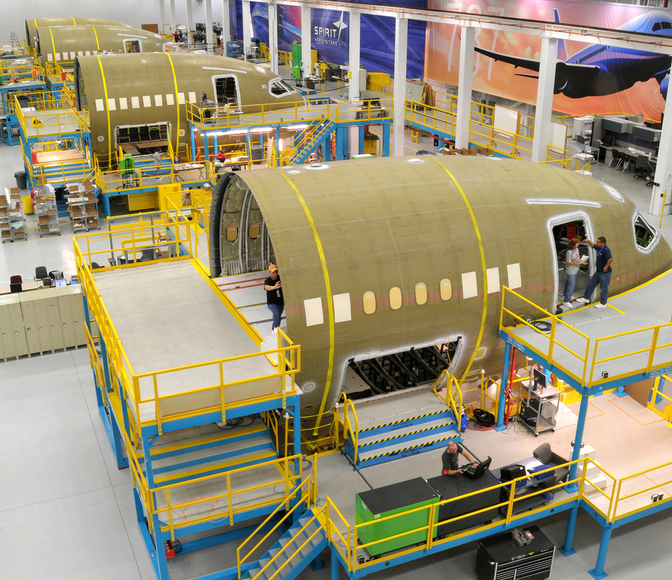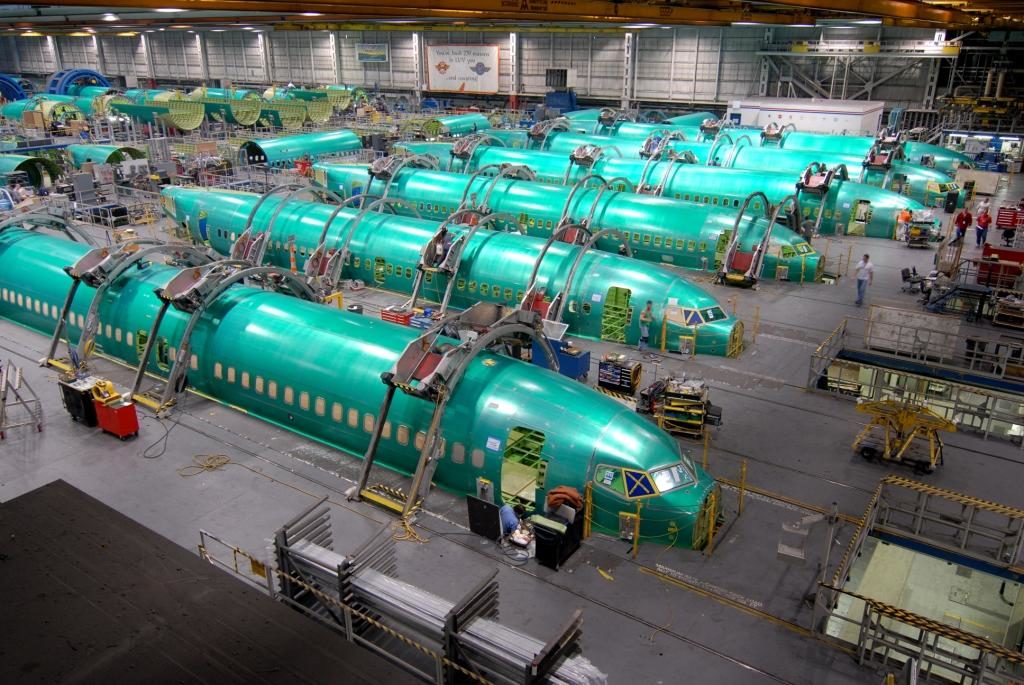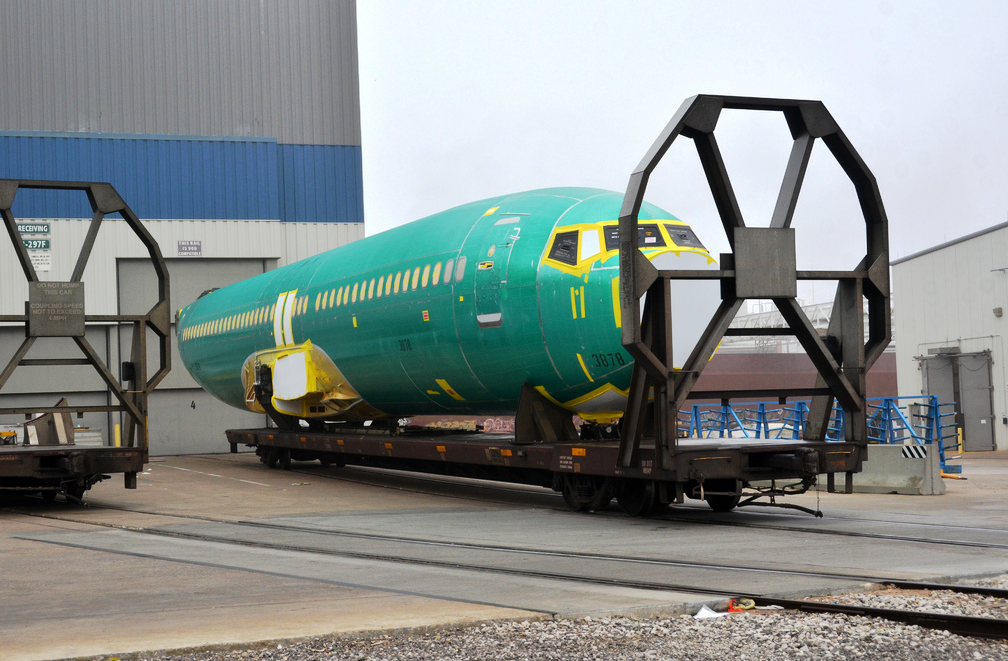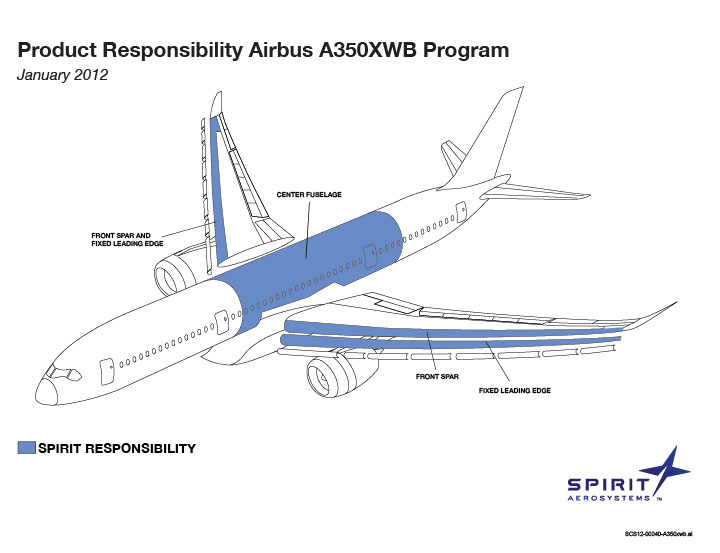Leeham News and Analysis
There's more to real news than a news release.
 Leeham News and Analysis
Leeham News and Analysis
- Solid start for stand-alone GE Aerospace despite cuts to LEAP output April 23, 2024
- SPEEA, Boeing at impasse over safety program, union says April 23, 2024
- Better transparency needed on Boeing’s 1Q earnings call April 22, 2024
- Bjorn’s Corner: New engine development. Part 4. Propulsive efficiency April 19, 2024
- Boeing unlikely to meet FAA’s 90-day deadline for new safety program April 18, 2024
Spirit AeroSystems, the world’s largest aerostructures company
A feature report.
By Bjorn Fehrm
March 15, 2017, ©. Leeham Co: Spirit AeroSystems is the world’s largest aerostructures supplier, with main facilities in Wichita (KS). I visited Wichita early March and was given a guided tour of the factories. It was a tour of contrasts.
In production hall two, the Boeing 737 fuselages are riveted together in much the same way as the Boeing B-29 Stratofortress was produced there during World War II. “Rosie the riveter” is replaced with a robot, but the hall still has a busy charm.
In another hall, the production is silent. The winding of the Boeing Dreamliner’s forward fuselage from rolls of tape is made with a swooshing sound. There are few people around; the machines rule. Everything is mega large; tape-layers, tools, autoclaves, the lot.
In Wichita for 90 years
Spirit was formed 2005 when the civil production was spun off from Boeing’s defense production plants in Wichita. The site produced the B-52, B-47 and B-29, among others, over the decades.
The factory origin dates from the 1920s, when Loyd Stearman produced the legendary “Kaydet” trainer in the Stearman aircraft factory in Wichita. The windy plains were ideal for the aircraft of the time. No obstacles in sight and wind to help the aircraft take off. Wichita was the aircraft center of the US, with companies like Cessna, Beechcraft, Mooney and Stearman.
Boeing acquired Stearman at the time, both being part of United Aircraft and Transport Corporation. Boeing later dropped the Stearman brand.
The Boeing Stearman plant grew and during the Second World War, it produced the B-29 Superfortress bomber. With a huge need for labor, women were hired onto the production lines where they riveted the giant bombers, turning out four a day. “Rosie the riveter” changed people’s mind about women and industrial production.
Boeing production
With the 737 fuselage and the 787 forward fuselage as highlights, the Spirit production is unusually varied. During the tour, I could see “Metal in-Part out” production cells that feed the many production lines. Spirit produces many of its sub-assemblies. What Spirit doesn’t do, it gets sourced from sub-suppliers.
The metal production facilities are used in production of forward fuselages for 747, 767 and 777, as well the complete fuselage for the 737.
The 737 production line is equipped with robots and advanced laser aligning equipment. The line is totally flexible regarding the produced variant. A 737-700 fuselage can precede a MAX 9 fuselage followed by a 737-800.
Output is presently 1.3 fuselages per day with an increase planned to 1.9 per day. The fuselage is produced in a corrosion-protection green and sent by rail to final assembly at Renton (WA), Figure 2.
The 787 forward fuselage production is impressive. Spirit goes from a mandrel-wrapped with CFRP (Carbon Fibre Reinforced Plastic) tape to an equipped forward fuselage within the facility, Figure 3.

Figure 3. Boeing 787 nose sections being stuffed with systems at Spirit. Source: Spirit AeroSystems.
Before it ships, it’s tested for complete functionality, including cockpit avionics functions. I was surprised to spot an installed nose landing gear in the units that were ready to ship to Boeing’s Everett plant (flown with the 747 Dreamlifter).
The wing production section is producing leading and trailing edge components (slats, flaps) for the 737, 747, 767, 777 and 787.
Spirit is also producing all engine struts (called pylons in Europe) for Boeing Civil Aircraft, and most of the nacelles. I could see the strut and nacelles for Boeing’s 747, 767 and 777, both the -300ER and the new 777X.
Airbus production
Spirit is also active in Airbus programs. The company builds the wing leading and trailing edge elements of all the A320 aircraft and the droop slats for the A380 at its Prestwick, Scotland, facilities.
The A350 is a more important program. Spirit makes the central section as CFRP panels in Kinston (NC) and then builds them to fuselage section 15 in a factory in St Nazaire, Figure 4, France. The wing’s front spar and fixed leading edge are also within Spirit’s deliveries.
Other projects
Spirit is also active in Boeing’s military derivatives of the civil airliners. Current programs are P8 Poseidon and KC46. The product range also includes Helicopter cabins (CH-53K, Bell V280), nacelles for the Gulfstream 650 and struts for Bombardier CSeries and Mitsubishi MRJ.
Summary
It was fascinating to see so many different manufacturing techniques in one day. It went from hand riveting of tricky sections for a classical Boeing aircraft to the advanced assembly of complete 787 nose sections.
The 787 program is unique for Spirit. It’s the first program where the company not only does the structure but the whole aircraft section including all its systems/avionics. Delivered is a complete functional unit, tested to all its functionality.
The company is a production powerhouse.
Related
Category: Airbus, Boeing, Boeing KC-X tanker, Bombardier, CSeries, Mitsubishi, Spirit Aerosystems
Tags: 737, 737 MAX, 747-8, 777-300ER, 777X, 787, A320NEO, A350, Airbus, Boeing, Bombardier, Mitsubishi
34 Comments on “Spirit AeroSystems, the world’s largest aerostructures company”
Leave a Reply Cancel reply
Email Subscription
Twitter Updates
My TweetsAssociations
Aviation News-Commercial
Commentaries
Companies-Defense
Resources
YouTube
Archives
- April 2024
- March 2024
- February 2024
- January 2024
- December 2023
- November 2023
- October 2023
- September 2023
- August 2023
- July 2023
- June 2023
- May 2023
- April 2023
- March 2023
- February 2023
- January 2023
- December 2022
- November 2022
- October 2022
- September 2022
- August 2022
- July 2022
- June 2022
- May 2022
- April 2022
- March 2022
- February 2022
- January 2022
- December 2021
- November 2021
- October 2021
- September 2021
- August 2021
- July 2021
- June 2021
- May 2021
- April 2021
- March 2021
- February 2021
- January 2021
- December 2020
- November 2020
- October 2020
- September 2020
- August 2020
- July 2020
- June 2020
- May 2020
- April 2020
- March 2020
- February 2020
- January 2020
- December 2019
- November 2019
- October 2019
- September 2019
- August 2019
- July 2019
- June 2019
- May 2019
- April 2019
- March 2019
- February 2019
- January 2019
- December 2018
- November 2018
- October 2018
- September 2018
- August 2018
- July 2018
- June 2018
- May 2018
- April 2018
- March 2018
- February 2018
- January 2018
- December 2017
- November 2017
- October 2017
- September 2017
- August 2017
- July 2017
- June 2017
- May 2017
- April 2017
- March 2017
- February 2017
- January 2017
- December 2016
- November 2016
- October 2016
- September 2016
- August 2016
- July 2016
- June 2016
- May 2016
- April 2016
- March 2016
- February 2016
- January 2016
- December 2015
- November 2015
- October 2015
- September 2015
- August 2015
- July 2015
- June 2015
- May 2015
- April 2015
- March 2015
- February 2015
- January 2015
- December 2014
- November 2014
- October 2014
- September 2014
- August 2014
- July 2014
- June 2014
- May 2014
- April 2014
- March 2014
- February 2014
- January 2014
- December 2013
- November 2013
- October 2013
- September 2013
- August 2013
- July 2013
- June 2013
- May 2013
- April 2013
- March 2013
- February 2013
- January 2013
- December 2012
- November 2012
- October 2012
- September 2012
- August 2012
- July 2012
- June 2012
- May 2012
- April 2012
- March 2012
- February 2012
- January 2012
- December 2011
- November 2011
- October 2011
- September 2011
- August 2011
- July 2011
- June 2011
- May 2011
- April 2011
- March 2011
- February 2011
- January 2011
- December 2010
- November 2010
- October 2010
- September 2010
- August 2010
- July 2010
- June 2010
- May 2010
- April 2010
- March 2010
- February 2010
- January 2010
- December 2009
- November 2009
- October 2009
- September 2009
- August 2009
- July 2009
- June 2009
- May 2009
- April 2009
- March 2009
- February 2009
- January 2009
- December 2008
- November 2008
- October 2008
- September 2008
- August 2008
- July 2008
- June 2008
- May 2008
- April 2008
- March 2008
- February 2008





Thanks for sharing this Bjorn, very nice to see.
The interesting shift besides the material is the entire process:
The B737 looks finished, but is a basically empty metal shell.
The B787 is partly or fully equipped.
Both have ups and downs.
The myth that the B787-process (in its entirety) yielded cost savings can be considered busted, while the reason for that are complex.
I don’t understand this comment. If cost savings were not yielded, then why do they continue to ship them this way? Surely they would have made a change by now. It strikes me that what Bjorn observed tends to support the view that the concept of the 787 process, while flawed in implementation, has in fact been validated.
The process of ‘completed assemblies’ was fundamental to the original Airbus concept developed under Felix Kracht. Whether it has been vindicated here is a moot point. Once the process has been defined, particularly when considering supplier contracts, it is very unlikely to be changed regardless of subsequent issues efficiency.
So, regardless of who developed the concept, which is no more, and in reality quite a bit less, relevant than its impact in the aerospace manufacturing world, the verdict will perhaps depend more on how the next generation of supplier contracts is structured.
Its never a black and white situation and has varied with the plane and company over the years.
When Douglas made the DC9, they arranged what was for them , a risk sharing contract with De havilland Canada to build the wing at Malton Toronto. It turned into custard and Douglas bought the whole factory which remained building wings up to Boeings ownership. Now closed and buildings demolished.
Ref: What killed Douglas Aircraft
https://faculty.haas.berkeley.edu/leonard/Active%20Papers/What%20Killed%20Douglas%20Aircraft.pdf
I certainly wasn’t suggesting the idea was invented with Airbus. More that it was fundamental to the manner in which Airbus operated.
“Sektionalbau.”
WWII German submarines were produced in complete, more or less fully fitted out sections, on spread out manufacturing sites and then assembled at a shipyard. Made production cheaper and faster. This carried over into general shipping construction after the war. No idea if lifting this concept from shipping was Kracht’s personal idea. ( Kracht worked at DFS during the war on a wide range of projects including an “interplane” towing and fuel transfer system)
Ww2 german subs built that way suffered from terrible fit problems due to poor quality control. Great idea but beyond their abiliity to carry out as intended at the time.
Not everybody falls short on learning and repeats mistakes ad nauseam.
If you watch some video of A380 fuselage segments joined they seem to have it down pat from day one 🙂
Aircraft production by sub assemblies was widespread on both sides during the War, necessity meant that factories that werent familiar with aircrft production techniques were used as well. The mostly wooden Mosquito could have parts made in furniture factorys, the US Army Airforce had a stainless steel trainer – BT-12, designed to use spot and seam welding from a specialist company, Fleetwings. Not needed as other Al planes could be still made.
Sub contracted assemblies were common with commercial aircraft after the war, the advance used by Douglas with the DC-9 was using a risk sharing partner, and they then had a lot of the same problems that Boeing had 40 years later with the 787 . History repeats, as they say.
As a history aside, all German equipment had issues from about 1942 on in quality.
they incorporated the occupied countries into production and much slave and non voluntary labor. Sabotage was rampant.
As for the 787 production setup, it has serious flaws, its costly with no ability for direct oversight. Offset supposedly by others paying for their cost (didn’t work out so good, mainly incompetent implantation of a scheme that was/is viable, maybe not the best)
How Boeing says they should have had all it setup in a circle around Everett.
It works, Airbus started it due to the need to deal with the company setup in many different locations and to haul them to the central assembly (Toulouse to start with)
Big chunks of the 767 are mad in Japan and that worked fine, though they are shipped by sea.
Per Bjorn, both 787 and A350 systems work, Boeing is making money now on the 787 so the costs are offset and viable.
Its cost issue were the program screw ups, per aircraft its had a normal come down in costs though its not a wonder thing where they were able to snap them together in 3 days either.
As our illustrious president has noted, its complicated. Of course I think answering the door for him his complicated .
I must say the de Havilland Malton plant, started out as Victory Aircraft during the war but then was bought by Avro Canada, and this was the location where the first North American jet liner , C102 was built and flew in 1949 ( 2 weeks after the Comet). At least the plant ended up doing a major role for a worthy successor the DC-9
Thanks Bjorn.
Interesting read. Loved it.
I wish people would remember more than Rosie the Riveteer when thinking of womens contribution to avation during the war.
Women also flew bombers and fighters and transports, but mostly only as ferry pilots, however some did transport cargo in US and towed targets for AA training.
And US pilot union(s) got them blocked from flying for airlines.
Somehow those individuals who test flew hastily built airplanes and ferried them across the stormy North Atlantic without good weather forecasting were emotionally unsuited to fly pax.
Shame!
Spirit won the A350 package in competition with Alenia. Airbus judged Spirit did better on the 787 than Alenia. Both supplier are OK today.
How complete are the 737 fuselages?
stuffed already?
They are shells only. The stuffing is done in Renton.
It’s Kinston, NC, not Kingston.
Thanks.
Work there. The fuselage areas are neat on the eyes but they should have shown you the building where most of the money is made in IPB4, where all of the Thrust reversers are constructed for all Boeings current 737 NG and the new 737MAX. We make all the new orders as well as the replacement parts. Shame they just opened a big new section of the building to accommodate production since we will be making for 60 planes a month up from 42 now.
Thanks, its good to hear from the folks doing the work!
Bjrorn: Thank you, I love that in depth stuff.
When I was a kid they used to have leader film called “Industry on Parade” Really cool to see how things were made. We have got too far away from that.
When we went stateside my Aunt would get us into factories to see beer and ding dongs or some such made. Neat.
One of the real disappointment of my life was I got onto the USS Constellation and it was so late they no longer were doing tours of the machinery spaces.
Drats. I mean that where it all is at, machinery is what makes the world go not apps!
If anyone is about setup to make an all new modern aircraft, its Spirit!
As a 33 year employee in this factory, I appreciate that others see the amazing work going on inside the buildings. I am amazed daily at what the Spirit team does accomplish. Thank you for the article.
I too am amazed.
I know its usaualuy kep in house on how diffiiucl or even how bad things go, but I never heard a peep tha the single most diffulat and theoalicly compelxt part of the 787 (the nose) had any problems.
It never was mentioned in any of the delays as an issue.
If there were problems they were overcome (and I know there always are, sometimes awfully tough ones and sometimes just let figure it out guy and it gets done) . We do know there were some A350 issues, it is not easy or anyone could do it!
So, congratulations is in order for the entire facility.
Did the Spirit plant in Wichita limit the length of the 737-10 fuselage length ? The completed fuselages for all the 737 are railed to Seattle and that might mean some hard limits to the rail cars dimensions to travel on some curves or tunnels.
I know the longer 757 was railed from Wichita in two fuselage sections after the construction was moved from Renton in 2002, they were hoping orders would pick up , but didnt as production ended in 2004. The fuselage construction seemed to move around a bit. First it was made by North American at Tulsa but dropped when they needed that plant for the new B-1B. No wonder the 757 costs were high , 3 fuselage build locations.
The Tulsa plant is now shared with Spirit and Triumph group which combines Vought and Avco ( who grew out of the Stinson plant in Nashville)
@Duke: The MAX 10 could have gone +122 inches (or something like that), the maximum for railroading to Seattle. But then you have to get into taller gear, a different center box, this, that and another thing and Boeing just wasn’t willing to go there.
A good 6 part series from Seattle Times on the development /design/production of the 757
http://old.seattletimes.com/news/business/757/
Just as relevant today on the challenges on a totally new plane and what the customers do or dont want?
Interesting bits , I didnt know they were closely looking at British Aerospace ( or its predecessor) to design and build the 757 wing.
If Boeing had known how the new plane market was going to play out , they wouldnt have made both 757 and 767. But didnt have a crystal ball of course.
At that time both the 737 and 747 programs werent seen as profitable- lessons for today on that!
I would be interested in finding out why Boeing would not have done the 767 and 757?
Both were successful, actually very successful for their time.
Granted the 757 is gone, and maybe somewhat less, but it did sell 1000 and you have to wonder if they had upgraded it?
The 767 continues on, granted mostly as a tanker but also cargo for FedEx and very likely UPS will add more. That puts it at 1500 or so for its lifetime (yet to be determined of course)
USAF is actually talking about keeping KC135s to assist KC46 so likely more KC46 than the 179.
It was the comments at the time -early 80s. I think the 757 was struggling – no new orders other than the launch customers- but they grew the 767 to better differentiate it from the 757. In the end it was the 767-200 which has largely disappeared from use while the 757-200 stayed as a workhorse.
What fascinated me most was the statement from the head of the 757 program Condit, that he wouldnt enough information to understand and make major decisions, but that he would decide the timing of those decisions.
Seattle Times made the observation that the management of engineering staff would be split in some areas, so as to allow contrary opinions to flow up to the top.
Keeping the KC-135 is more related to KC-46 being late.
With about 8 additional freighters per year Boeing can maintain a 767 production of about per month. So maybe there are several freighter slots still available until the end of 179 KC-46 order.
I doubt USAF requires more tanker with a shrinking fleet due to more and more expensive aircraft. E.g. a B-52MAX will require far less tanker than the current version. A far bigger tanker might be required for Pacific operations.
Per comments from the USAF, they don’t have enough tankers with all the activity going on and plan on keeping the now active updated KC135 in service rather than retire them.
As the B-52 is not updated yet and will not be even if its a go for 10 years, that is not relevant.
Bigger tankers cannot fuel more aircraft.